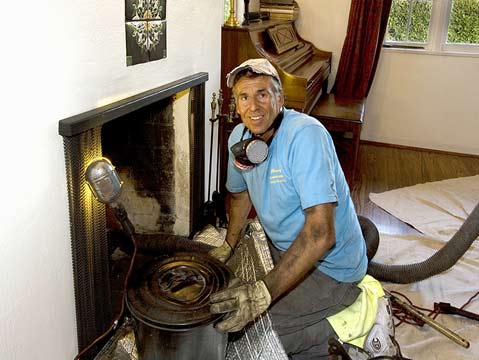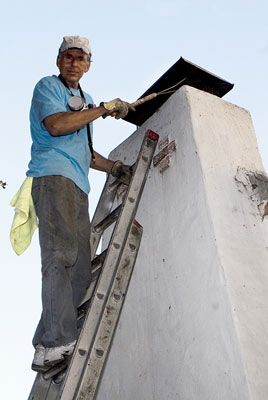Holiday Fire Safety
Advice from Chimney Sweep and a Firefighter

Before you hang the stockings and mistletoe with care, here are some core tips on fire safety to keep you safe and celebrating. They are from Santa Barbara’s own George Murdoch, of the Clean Sweep Company, and Geri S. Ventura, Montecito Fire Department.
Fireplaces need to be inspected yearly for safety, and chimneys cleaned after every cord of wood burned. Each chimney is required to have a spark arrestor and rain cap. Chimney fires are usually caused by soot, creosote, and obstructions. Creosote is a term for carbon products from wood burning that builds up on chimney walls. If the buildup is greater than one quarter-inch thick, it can ignite and cause a chimney fire. These fires are very dangerous, having temperatures up to 2000 degrees and often displaying 10-foot flames coming out of the top of the chimney. After a chimney fire, the fire department will “condemn” the fireplace until it passes inspection and is cleaned.

Some woods burn cleaner than others, such as oak, eucalyptus, and avocado, but more importantly, the wood must be seasoned, meaning dry, so it burns rather than smolders. Install a screen, or glass doors, to completely cover the fireplace opening and keep sparks from flying out. And keep the damper open when the fireplace is in use.
Check smoke alarms and have a type ABC fire extinguisher near the fireplace.
Keep children, combustible materials such as carpets, furniture, paper, logs and kindling at least three feet away from the fireplace.
Arrange andirons so logs can’t roll out.
Avoid “roaring” fires. Use only enough wood to have a warm fire.
Do not use gasoline or other flammable liquids to kindle or rekindle a fire because the flammable vapors can explode. Never use fuels near a fire as explosive vapors can travel the length of a room.
Never burn Christmas trees, gift-wrap paper, colored newspaper, coal, charcoal, or polystyrene packaging in a fireplace.
Be sure that all ashes have thoroughly cooled before you dispose of them. Put ashes in a lidded metal container to prevent a possible fire and provide a sturdy place to store them. Ashes make good fertilizer in gardens, flowerbeds, etc.
Candles used for Chanukah and other holidays need to be in stable holders and placed where they cannot be easily knocked down. Never leave the house with candles burning. Never put lit candles on a tree or go near a Christmas tree with an open flame from candles, lighters, or matches.
Fresh and artificial Christmas trees should be treated with a fire retardant. Live cut trees should not be dried out or placed near heaters and fireplaces. Keep water in the tree stand and after two weeks take the tree down to a recycling center or arrange a local pick up.
Inspect your holiday lights for frayed wires, bare spots, gaps in the insulation, broken or cracked sockets, and excessive kinking or wear before putting them up. Use only UL lighting or lights listed by an approved testing laboratory. Do not link more than three light strands, unless the directions indicate it is safe.
Connect strings of lights to an extension cord before plugging the cord into the outlet.
Make sure to periodically check the wires: They should not be warm to the touch.
And of course, as with candles, do not leave your inside holiday lights on unattended.
Holiday decorations should be nonflammable or flame-retardant and placed away from heat vents.



